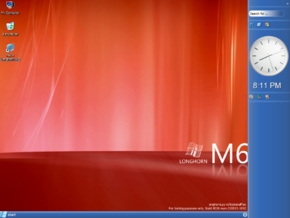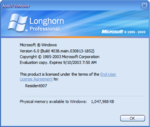Windows Longhorn build 4038
| Build of Windows Longhorn | |
 | |
| OS family | Windows NT |
|---|---|
| Version number | 6.0 |
| Build number | 4038 |
| Architecture | x86 |
| Build lab | main |
| Compiled on | 2003-08-13 |
| Expiration date | |
| Timebomb | 2004-02-09 (+180 days) |
| SKUs | |
| Professional | |
| Product key | |
| TCP8W-T8PQJ-WWRRH-QH76C-99FBW | |
| About dialog | |
Windows Longhorn build 4038 is a Milestone 6 build of Windows Longhorn. On 23 January 2020, this build was listed on a thread by UX.Unleaked blog founder Grabberslasher to be released to BetaArchive's FTP server, and was released in the seventh set of his 33 Longhorn/Vista builds, along with its server counterpart.
New features and changes[edit | edit source]
Setup[edit | edit source]
This is currently the first build of Longhorn to contain the entirety of the Setup inside the install.wim image, rather than having it separated on a BOOT folder.
As the Setup header now contains a back and a cancel button, the respective buttons located in the client area have been removed. Upon hovering over an option, the cursor now also changes its state to indicate a selection.
The upgrade page is now organized horizontally rather than vertically. The word "Page" has also been removed from the title of each Setup step.
The Computer Name step has been updated to feature more information about computer names, with it now telling the user that the computer name helps identify their computer, and that the name will appear on the login screen. Along with this, it now also describes that if the computer is part of a network, its name must be different from all other computers on that network.
User interface[edit | edit source]
The File Sharing Wizard has received the Aero Wizard look, with the wizard's respective banner containing a glass folder icon and the text "Who do you want to share this folder with?".
The MessageBox feature has been removed from the Alarm option of the Clock tile.
Windows Explorer[edit | edit source]
A window can now be moved by clicking and dragging the empty space present between the titlebar and navigation pane. Additionally, double-clicking the aforementioned space will now also maximize the window.
While the 3D view spinning icons have been brought back, the title of each icon is no longer present.
The Panorama 3D view now sorts icons by name rather than date. Each application's icon is now also present between the previously empty space.
The "OK", "Cancel" and "Apply" buttons are now larger in the Explorer Properties menu.
A prototype of the Communication History folder has been added.
Assistance[edit | edit source]
The Help and Support program has been replaced with Assistance, otherwise known as the Longhorn Help Place. While the application is still mostly identical to the aforementioned help place, many improvements have been implemented.
Hot Issues has been replaced with Frequently Asked Questions, which, while not actually a FAQ section, contains five tasks that a user can perform (as nearly all tasks repeat themselves). A more FAQs button is also present, which when clicked, opens the All Tasks folder. The current date, month and year is also present in the top right corner.
Two new links have been added to the home page of the application: Browse Solutions and Ask your community. The former of which opens the previously mentioned folder, while the latter opens either a Microsoft community website or Outlook Express.
Desktop Compositing Engine[edit | edit source]
The Desktop Compositing Engine is now fully functional, as Direct3D shaders are now properly utilized on capable hardware. By default, the system is set up to use the default opaque borders, although transparent borders can be enabled by tricking desksrv.dll into thinking that the user has access to the private Aero theme, with instructions on how to do so present on the Windows Aero page.
DCE can be started or stopped by executing sbctl start or sbctl stop in the C:\Windows\i386 directory.
Bugs and quirks[edit | edit source]
Installation[edit | edit source]
- It is currently not possible to upgrade this build, as after the second reboot, Windows will corrupt the registry and will fail to boot, resulting in a
Windows could not start because the following file is missing or corrupt: \WINDOWS\system32\config\SYSTEMerror upon booting.
- Upgrading to this build will cause
lsass.exeto throw out an error upon boot up, rendering the system unbootable.
Desktop Compositing Engine[edit | edit source]
While this build's Desktop Compositing Engine can now render the metal/glass window frames, the engine itself suffers from rendering glitches that fail to refresh a window's graphical content unless the window is resized.
Safe mode[edit | edit source]
By default, it is not possible to login while in Safe mode. Due to the login process change done in build 4032, the "User Profiles Service" and "Group Policy Service" are required to access the login page and perform the login process respectively. Because these services are not configured by default to start within Safe mode, this results in logonui.exe showing the error "There are no more endpoints available from the endpoint mapper" on the login screen and failing to show available user accounts.
These services can be enabled to function in safe mode by adding the following entries to the service whitelists in the registry:
[HKEY_LOCAL_MACHINE\SYSTEM\CurrentControlSet\Control\SafeBoot\Minimal\ProfSvc]
@="Service"
[HKEY_LOCAL_MACHINE\SYSTEM\CurrentControlSet\Control\SafeBoot\Minimal\GPSvc]
@="Service"
[HKEY_LOCAL_MACHINE\SYSTEM\CurrentControlSet\Control\SafeBoot\Network\ProfSvc]
@="Service"
[HKEY_LOCAL_MACHINE\SYSTEM\CurrentControlSet\Control\SafeBoot\Network\GPSvc]
@="Service"










